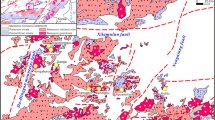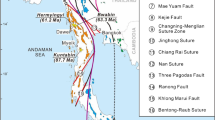Abstract
We present Mo isotope compositions of molybdenite types from three successive stages of ore deposition in several porphyry copper deposits of the Kerman region, Iran. The data provide new insights into controlling processes on Mo isotope fractionation during the hydrothermal evolution of porphyry systems. The Mo isotope compositions of 27 molybdenite samples show wide variations in δ97Mo ranging from −0.37 to +0.92 ‰. The data reveal that molybdenites in the early and transitional stages of mineralization (preferentially 2H polytypes; δ97Mo mean = 0.35 ‰) have higher δ97Mo values than late stage (mainly 3R polytypes; δ97Mo mean = 0.02 ‰) molybdenites. This trend suggests that fractionation of Mo isotopes occurred in high-temperature stages of mineralization and that hydrothermal systems generally evolve towards precipitation of molybdenite with lower δ97Mo values. Taking into account the genetic models proposed for porphyry Cu deposits along with the temperature-dependent fractionation of Mo isotope ratios, it is proposed that large variations of Mo isotopes in the early and the transitional stages of ore deposition could be controlled by the separation of the immiscible ore-forming fluid phases with different density, pH, and ƒO2 properties (i.e., brine and vapor). The fractionation of Mo isotopes during fluid boiling and Rayleigh distillation processes likely dominates the Mo isotope budget of the remaining ore-forming fluids for the late stage of mineralization. The lower δ97Mo values in the late stage of mineralization can be explained by depletion of the late ore-forming hydrothermal solutions in 97Mo, as these fluids have moved to considerable distance from the source. Finally, the relationship observed between MoS2 polytypes (2H and 3R) and their Mo isotopic compositions can be explained by the molecular vibration theory, in which heavier isotopes are preferentially partitioned into denser primary 2H MoS2 crystals.






Similar content being viewed by others
References
Anbar AD (2004) Molybdenum stable isotopes: observations, interpretations and directions. Rev Mineral Geochem 55:429–454
Anbar AD, Knab KA, Barling J (2001) Precise determination of mass-dependent variations in the isotopic composition of molybdenum using MC-ICPMS. Anal Chem 73:1425–1431
Asadi S, Moore F, Zarasvandi A, Khosrojerdi M (2013) First report on the deposits of CO2-bearing fluid inclusions in the Meiduk porphyry Cu deposit, Iran: implications for mineralization processes in a continental collision setting. Geologos 19(4):301–320. doi:10.2478/logos-2013-0019
Barling J, Arnold GL, Anbar AD (2001) Natural mass-dependent variations in the isotopic composition of molybdenum. Earth Planet Sci Lett 193:447–457
Bigeleisen J, Mayer MG (1947) Calculation of equilibrium constants for isotopic exchange reactions. J Chem Phys 15:261–267
Bomeri M, Nakashima K, Lentz DR (2009) The Miduk porphyry Cu deposit, Kerman, Iran: a geochemical analysis of the potassic zone including halogen element systematics related to Cu mineralization processes. J Geochem Explor 103:17–29
Bomeri M, Nakashima K, Lentz DR (2010) The Sarcheshmeh porphyry copper deposit, Kerman, Iran: a mineralogical analysis of the igneous rocks and alteration zones including halogen element systematic related to Cu mineralization processes. Ore Geol Rev 38:367–381
Burnham CW (1979) Magmas and hydrothermal fluids. In: Barnes HL (ed) Geochemistry of hydrothermal ore deposits, 2nd edn. Wiley, New York
Candela PA, Holland HD (1984) The partitioning of copper and molybdenum between silicate melts and aqueous fluids. Geochim Cosmochim Acta 48:373–380
Cao X, Richardson SM, Richardson CK (1988) Solubility of molybdenite (MoS2) in hydrothermal solutions. Geol Soc Am Abstr Programs 20:A43
Cline JS (1995) Genesis of porphyry copper deposits: the behavior of water, chloride, and copper in crystallizing melts. In: Pierce FW, Bolm JG (eds) Porphyry copper deposits of the American cordillera. Ariz Geol Soc Dig 20:69–82
Drummond SE, Ohmoto H (1985) Chemical evolution and mineral deposition in boiling hydrothermal systems. Econ Geol 80:126–147
Etminan H (1977) Le porphyre cuprifère de SarCheshmeh (Iran), role des phases fluides dans les mécanismes d’altération et de minéralisation. Sci Terr Mem 34:78
Gammons CH, Williams-Jones AE (1997) Chemical mobility of gold in the porphyry-epithermal environment. Econ Geol 92:45–59
Greber ND, Hofman BA, Voegelin AR, Villa IM, Nägler TF (2011) Mo isotope composition in Mo-rich high-and low-T hydrothermal systems from the Swiss Alps. Geochim Cosmochim Acta 75:6600–6609
Greber ND, Pettke T, Nagler TF (2014) Magmatic–hydrothermal molybdenum isotope fractionation and its relevance to the igneous crustal signature. Lithos 190–191:104–110
Guilbert JM, Lowell JD (1974) Variations in zoning patterns in porphyry ore deposits. CIM Bull 67:99–109
Gustafson LB, Hunt JP (1975) The porphyry copper deposit at El Salvador, Chile. Econ Geol 70:857–912
Gustafson LB, Quiroga J (1995) Patterns of mineralization and alteration below the porphyry copper orebody at El Salvador, Chile. Econ Geol 90:2–16
Hannah JL, Stein HJ, Wieser ME, de Laeter JR, Varner MD (2007) Molybdenum isotope variations in molybdenite: vapor transport and Rayleigh fractionation of Mo. Geology 35:703–706
Haynes SJ, Ghorashi-Zadeh M (1978) Hydrothermal alteration, Cu mineralization, and supergene pattern, SarCheshmeh, Iran. Econ Geol 73:1391–1392 [Abs]
Hedenquist JW, Lowenstern JB (1994) The role of magmas in the formation of hydrothermal ore deposits. Nature 370(6490):519–527
Heinrich CA (2005) The physical and chemical evolution of low-salinity magmatic fluids at the porphyry to epithermal transition: a thermodynamic study. Miner Deposita 39:864–889
Heinrich CA, Ryan CG, Mernagh TP, Eadington PJ (1992) Segregation of ore metals between magmatic brine and vapor: a fluid inclusion study using PIXE microanalysis. Econ Geol 87:1566–1583
Heinrich CA, Günther D, Audétat A, Ulrich T, Frischknecht R (1999) Metal fractionation between magmatic brine and vapor, determined by microanalysis of fluid inclusions. Geology 27:755–758
Henley RW, McNabb A (1978) Magmatic vapor plumes and groundwater interaction in porphyry copper emplacement. Econ Geol 73:1–20
Hezarkhani A (2006) Hydrothermal evolution of the SarCheshmeh porphyry Cu–Mo deposit, Iran: evidence from fluid inclusions. J Asian Earth Sci 28:409–422
Hoefs J (2004) Stable isotope geochemistry. Springer Publication. 201p
Kurdin AV (1989) Behavior of Mo in aqueous NaCl and KCl solutions at 300-450°C. Geochem Int 26:87–99
Lowell JD, Guilbert JM (1970) Lateral and vertical alteration-mineralization zoning in porphyry ore deposits. Econ Geol 65:373–408
Mathur R, Titley S, Ruiz J, Gibbins S, Friehauf K (2005) A Re-Os isotope study of sedimentary rocks and copper-gold ores from the Ertsberg District, West Papua, Indonesia. Ore Geol Rev 26:207–226
Mathur R, Brantley S, Anbar A, Munizaga F, Maksaev V, Newberry R, Vervoort J, Hart G (2010) Variation of Mo isotopes from molybdenite in high-temperature hydrothermal ore deposits. Miner Deposita 45:43–50
McCandless TE, Ruiz J, Campbell AR (1993) Rhenium behavior in molybdenite in hypogene and near-surface environments: implications for Re–Os geochronology. Geochim Cosmochim Acta 57:889–905
McSween HY, Richardson SM, Uhle ME (2003) Geochemistry; pathways and processes, 2nd edn. Columbia University Press, New York, 359 p
Nagaseki H, Hayashi K (2008) Experimental studies of the behavior of copper and zinc in a boiling hydrothermal system. Geology 36:27–30
Nast HJ, Williams-Jones AE (1991) The role of water–rock interaction and fluid evolution in forming the porphyry-related Sisson Brook W–Cu–Mo deposit, New Brunswick. Econ Geol 86:302–317
Nateghi A, Hezarkhani A (2013) Fluid inclusion evidence for hydrothermal fluid evolution in the Darreh-Zar porphyry copper deposit, Iran. J Asian Earth Sci 73:240–251
Newberry RJ (1979a) Polytypism in molybdenites (I): a non-equilibrium impurity-induced phenomenon. Am Mineral 64:758–768
Newberry RJ (1979b) Polytypism in molybdenites (II): relationships between polytypism, ore deposition/alteration stages and rhenium contents. Am Mineral 64:768–775
O’Neil JR (1986) Theoretical and experimental aspects of isotopic fractionation. In: Valley JW, Taylor HP, O’Neil JR (eds) Stable isotopes in high temperature geological processes. Rev Miner Geochem 16:1–40
Pietruszka AJ, Walker RJ, Candela PA (2006) Determination of mass dependent molybdenum isotopic variations by MC-ICP-MS: an evaluation of matrix effects. Chem Geol 225:121–136
Redmond PB, Einaudi MT, Inan EE, Landtwing MR, Heinrich CA (2004) Copper deposition by fluid cooling in intrusion-centered systems: new insights from the Bingham porphyry ore deposit, Utah. Geology 32:217–220
Rempel KU, Migdisov AA, Williams-Jones AE (2006) The solubility and speciation of molybdenum in water vapor at elevated temperatures and pressures: implications for ore genesis. Geochim Cosmochim Acta 70:687–696
Rempel KU, Williams-Jones AE, Migdisov AA (2008) The solubility of molybdenum dioxide and trioxide in HCl-bearing water vapour at 350°C and pressures up to 160 bars. Geochim Cosmochim Acta 72:3074–3083
Rempel KU, Williams-Jones AE, Migdisov AA (2009) The partitioning of molybdenum (VI) between aqueous liquid and vapor at temperatures up to 370°C. Geochim Cosmochim Acta 73:3381–3392
Roedder E (1971) Fluid inclusion studies on the porphyry-type ore deposits at Bingham, Utah, Butte, Montana, and Climax, Colorado. Econ Geol 66:98–118
Rusk BG, Reed MH, Dilles JH (2008) Fluid inclusion evidence for magmatic-hydrothermal fluid evolution in the porphyry copper-molybdenum deposit at Butte, Montana. Econ Geol 103:307–334
Schauble EA (2004) Applying stable isotope fractionation theory to heavy elements. In: Beard J, Albarède F (eds) Geochemistry of Non-traditional stable isotopes. Rev Miner Geochem 55:65–111
Seedorff E, Dilles JH, Proffett JM, Einaudi MT, Zurcher L, Stavast WJA, Johnson DA, Barton M (2005) Porphyry deposits: characteristics and origin of hypogene features. 100th Aniv Vol Econ Geol 251–298
Seo JH, Guillong M, Heinrich CA (2012) Separation of molybdenum and copper in porphyry deposits: the roles of sulfur, redox, and pH in ore mineral deposition at Bingham Canyon. Econ Geol 107:333–356
Shafiei B, Shahabpour J (2008) Gold distribution in porphyry copper deposits of Kerman region, southeastern Iran. J Sci Islam Rep Iran 19:247–260
Shafiei B, Shahabpour J (2012) Geochemical aspects of molybdenum and precious metals distribution in the Sar Cheshmeh porphyry copper deposit, Iran. Miner Deposita 47:535–543
Shafiei B, Haschke M, Shahabpour J (2009) Recycling of orogenic arc crust triggers porphyry Cu-mineralization in Kerman Cenozoic arc rocks, southeastern Iran. Miner Deposita 44:265–283
Shahabpour J, Kramers JD (1987) Lead isotope data from the SarCheshmeh porphyry copper deposit, Kerman, Iran. Miner Deposita 22:278–281
Smith RW, Norman DI, Popp CJ (1980) Calculated solubility of molybdenite in hydrothermal solutions. J Geol Soc Am Abstr Programs 12:A525
Taghipour N, Aftabi A, Mathur R (2008) Geology and Re–Os geochronology of mineralization of the Miduk porphyry copper deposit, Iran. Res Geol 58:143–160
Tossell JA (2005) Calculating the partitioning of the isotopes of Mo between oxidic and sulfidic species in aqueous solution. Geochim Cosmochim Acta 69:2981–2993
Ulrich T, Mavrogenes J (2008) An experimental study of the solubility of molybdenum in H2O and KCl-H2O solutions from 500 to 800°C, and 150 to 300 MPa. Geochim Cosmochim Acta 72:2316–2330
Urey HC (1947) The thermodynamic properties of isotopic substances. J Chem Soc Lond 562–581
Williams-Jones AE, Heinrich CA (2005) Vapor transport of metals and the formation of magmatic-hydrothermal ore deposits. Econ Geol 100:1287–1310
Wood SA, Samson IM (1998) Solubility of ore minerals and complexation of ore metals in hydrothermal solutions. In: Richards JP, Larson PB (eds) Techniques in hydrothermal ore deposits geology. Rev Econ Geol 10:33–80
Wood SA, Crerar DA, Borcsik MP (1987) Solubility of the assemblage pyrite-pyrrhotite-magnetite-sphalerite-galena-Au-stibnite-bismothinite-argentite-molybdenite in H2O-CO2-NaCl solutions from 200°C to 350°C. Econ Geol 82:1864–1887
Acknowledgments
This work is part of the research project “Mo, Re, and Os isotopes in molybdenites from Kerman porphyry Cu deposits” which was approved by the Research Council of Golestan University, Gorgan, Iran (project No. 90-1-30). This project was funded partly by a Golestan University grant to the first and second authors. The authors are sincerely grateful to National Iranian Copper Industries Company for providing samples. Isotope laboratories in University of Arizona, Washington State University, and Arizona State University, USA, are acknowledged for the Mo isotopic measurements. We gratefully acknowledge John Chapman (GSC) and Ryan Taylor (USGS) for constructive reviews and valuable comments which helped to improve the manuscript. The Chief Editor Bernd Lehmann and Associate Editor Karen Kelley are thanked for helpful suggestions and diligent editorial handling.
Author information
Authors and Affiliations
Corresponding author
Additional information
Editorial handling: K.D. Kelley
Rights and permissions
About this article
Cite this article
Shafiei, B., Shamanian, G., Mathur, R. et al. Mo isotope fractionation during hydrothermal evolution of porphyry Cu systems. Miner Deposita 50, 281–291 (2015). https://doi.org/10.1007/s00126-014-0537-0
Received:
Accepted:
Published:
Issue Date:
DOI: https://doi.org/10.1007/s00126-014-0537-0




